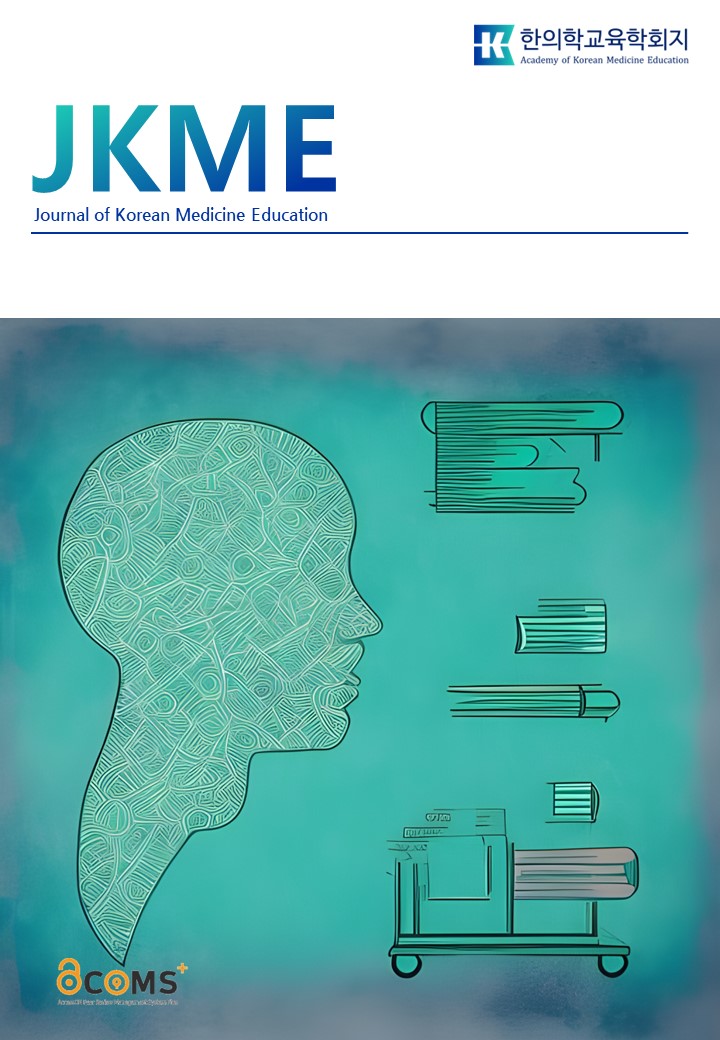2권 1호
초록
Abstract
The recent published article, "Possibility of implementing the Health Systems Science in Korean Medicine education" (J Kor Med Edu, 2023, Vol. 1, Issue 2, pp. 43-49), explores how Health Systems Science (HSS) educational domains integrate with the content of Korean medicine education, identifying both covered areas and those needing enhancement. It proposed ways to introduce HSS into Korean medicine education. This paper potentially initiates a crucial dialogue on innovating Korean medicine education through the introduction of HSS. In response, this letter aims to briefly explain HSS and further propose the possibility of integrating systems thinking education into Korean medicine education.
초록
Abstract
“A qualitative study on the factors of satisfaction and dissatisfaction of Korean medical college students in classes of pre-Korean medicine” published in the latest issue of the Journal of Korean Medicine Education (J Kor Med Edu, 2023, Vol. 1, Issue 2, pp. 50-62) is meaningful in that it explored the dissatisfaction factors and proposed a solution to the dissatisfaction factors. In particular, the significance of this study is great in that it can serve as a reference for revamping the Korean Medicine curriculum or improving and strengthening the teaching methods of professors in the college of Korean medicine. However, it is necessary to consistently present the scope of the curriculum and clarify the categories of satisfaction factors for the curriculum. Additionally, I do not agree with the discussion of the incomplete standardization of Korean medicine mentioned in the discussion and conclusion by applying it to the grading criteria for each subject test. This is because each subject, instructor, and student's learning method or attitude will have a more direct impact on student grades than academic standardization. Nevertheless, this study has implications for improving future Korean medicine education. As a follow-up study, a study is needed to investigate the satisfaction of the entire Korean medicine curriculum.
초록
Abstract
Background: Chuna manual therapy, performed by doctors of Korean Medicine, presents unique challenges compared to other treatment modalities. However, there is a lack of information for effective instructional strategies for Chuna manual therapy. This study aims to present the Chuna manual medicine course using various teaching, learning, and assessment methods. Methods: Prior to class, learners were provided with short online lectures to preview the procedural skills they would practice. A portfolio was introduced as an assessment tool to help students track their progress and achievements. Cooperative learning supplemented biomechanical knowledge, and peer assessments of group presentations encouraged learning from their peers’ biomechanical content. Additionally, an objective structured clinical examination (OSCE) was implemented to assess students’ actual performance alongside training quality. Results: Various teaching and learning methods, including flipped learning, portfolio assessment, cooperative learning, peer assessment, and OSCE, were employed to improve the effectiveness of education. Discussion and conclusion: Future research on the effects of the Chuna manual medicine course is warranted. Based on this study, active discussions are expected among subject matter experts and instructional designers to develop and implement effective theoretical and practical training programs for Chuna manual medicine.
초록
Abstract
Background: Sufficient training and clinical experience are required in acupuncture training curricula to ensure competency. However, the practice of medical students is limited and only allowed under certain conditions in Korea. This study aims to present a group project that provides additional acupuncture treatment experience in Meridian and Acupoint classes to bridge the gap between acupuncture training and clinical practice. Methods: We described and analyzed a group project implemented at a single college of Korean medicine since September 2022. An instructional designer, who is also a specialist in acupuncture and moxibustion medicine, designed the group project through discussion with a subject matter expert, the instructor of this class. As comments and complaints revealed this project was modified and redesigned for a new curriculum in 2023. Results: Assignments included pre-learning content, medical records, treatment notes, analysis of patient progress, and reflections on learning. Assessment based on a predefined rubric replaced the midterm examination and counted toward the students’ grades. Grading and feedback were done using Google Classroom. However, several complaints emerged: lack of motivation to learn, high learning burden, and inappropriate when they had not yet learned clinical subjects. The project model was redesigned to reflect their practice in class for the first semester, identify target anatomical structures in the needle tip for the second semester, and experience acupuncture treatment with less burden for the third semester. Discussion and conclusion: The experience of selecting and treating patients from their peers may be an alternative to the current clinical clerkship. Further studies on novel programs for early clinical practice and their effectiveness in Korean medicine education are needed.

